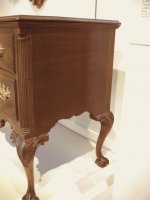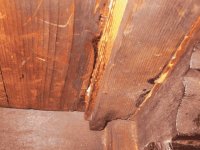I am planning to build the Philadelphia lowboy from the Dewitt-Wallace Museum.
Took lots of pictures, measurments, drew up all the carving, etc.
However - I am at a loss for how to inset the corner columns.
The quarter column is easy, the cabriole leg is easy, how do I marry the two?
An additional puzzler is that there appear to rectangular filler blocks both above and below the column.
Could the corner posts be separate from the legs? If so, how are they connected?
However, the shot taken of the bottom, seems to indicate the leg and corner post are one piece.
Any help or suggestions would be greatly appreciated.
Thanks,
Mike
Took lots of pictures, measurments, drew up all the carving, etc.
However - I am at a loss for how to inset the corner columns.
The quarter column is easy, the cabriole leg is easy, how do I marry the two?
An additional puzzler is that there appear to rectangular filler blocks both above and below the column.
Could the corner posts be separate from the legs? If so, how are they connected?
However, the shot taken of the bottom, seems to indicate the leg and corner post are one piece.
Any help or suggestions would be greatly appreciated.
Thanks,
Mike


